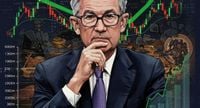The Federal Reserve finds itself at the epicenter of a heated debate over interest rates, inflation, and political pressure, as revealed by the minutes of its July 29-30, 2025 meeting. With the U.S. economy sending mixed signals and the Trump administration’s aggressive tariff policies looming large, central bankers are wrestling with a set of tradeoffs that could shape the country’s financial future for months to come.
According to the minutes released Wednesday and reported by CNBC, most Federal Reserve officials agreed that the threat of higher inflation outweighed concerns about potential job losses, prompting the central bank to keep its key interest rate unchanged at a target range of 4.25% to 4.5%. This decision came even as two members of the Fed’s governing board—Christopher Waller and Michelle Bowman, both Trump appointees—dissented in favor of a rate cut. Notably, this marked the first time in over 30 years that multiple governors voted against a consensus decision on interest rates, underscoring the growing divide within the Fed’s rate-setting committee.
The minutes, detailed by Reuters and TipRanks, painted a picture of a central bank deeply concerned about both sides of its dual mandate: keeping inflation under control and supporting maximum employment. “Participants generally pointed to risks to both sides of the Committee’s dual mandate, emphasizing upside risk to inflation and downside risk to employment,” the minutes stated. While most policymakers saw inflation as the greater risk, a couple—Waller and Bowman—believed that labor market weakness was a more pressing concern.
President Donald Trump’s sweeping tariffs were a central topic of discussion. The minutes, as cited by Stocktwits and Washington Times, highlighted “considerable uncertainty” about the timing, magnitude, and persistence of tariff-related effects on the U.S. economy. “Regarding upside risks to inflation, participants pointed to the uncertain effects of tariffs and the possibility of inflation expectations becoming unanchored,” the minutes noted. Officials observed that while the effects of higher tariffs had become more apparent in the prices of some goods, the overall impact on economic activity and inflation remained to be seen.
Despite the drama surrounding tariffs, inflation has only crept up in recent months, currently standing at 2.7% annually—just above the Fed’s 2% target but not soaring as many economists initially feared. Still, the specter of persistent inflation, especially if it becomes untethered from expectations, has left most Fed officials wary of cutting rates too soon. Chair Jerome Powell, speaking after the July meeting, signaled that it might take “significant additional time” to determine whether the tariffs are truly fueling inflation, according to AP News.
The labor market, meanwhile, has shown unmistakable signs of strain. The Bureau of Labor Statistics reported that only 75,000 jobs were added in July, well below expectations. Even more concerning, May and June employment figures were revised downward by a staggering 258,000 jobs, indicating a significant slowdown. The Fed minutes, released just ahead of Powell’s highly anticipated keynote address at the annual Jackson Hole symposium, acknowledged that “downside risk to employment had meaningfully increased with the slowing of the growth of economic activity and consumer spending, and that some incoming data pointed to a weakening of labor market conditions.”
These developments have fed into mounting speculation about the Fed’s next move. According to the CME Group’s FedWatch tool, there is an 82.9% to 85% probability that the central bank will cut its key rate by 25 basis points at its September 16-17 meeting. This projection is driven largely by the disappointing employment data, which has shifted the balance of risks in the eyes of investors and policymakers alike.
The political backdrop is anything but calm. President Trump has not been shy about criticizing Chair Powell, reportedly calling him “stupid” and “a loser,” while demanding more aggressive action to lower borrowing costs. Trump has also fired the Bureau of Labor Statistics chief over alleged job data manipulation and nominated Heritage Foundation economist E.J. Antoni as a replacement. The president’s pressure campaign extends to other Fed officials as well: he has demanded the resignation of Governor Lisa Cook over mortgage fraud allegations and has threatened to sue Powell over the cost of Fed building renovations, according to Washington Times. Trump’s Treasury Secretary, Scott Bessent, recently confirmed that 11 “very strong candidates” are being considered for Powell’s seat, with interviews scheduled around Labor Day. The Senate, meanwhile, is weighing the nomination of Trump appointee Stephen Miran for a Fed Board vacancy.
Within the Fed, the minutes revealed a genuine debate over how to balance the competing risks. The summary noted, “Participants noted that the Committee might face difficult tradeoffs if elevated inflation proved to be more persistent while the outlook for the labor market weakened.” The approach to possible interest rate cuts would depend on “each variable’s distance from the Committee’s goal and the potentially different time horizons over which those respective gaps would be anticipated to close.”
Despite the high drama, Powell has so far maintained a steady course, insisting that the central bank’s decisions will be guided by economic data, not political pressure. All eyes will be on his Friday address at Jackson Hole for any clues about the Fed’s direction, both in the short and longer term.
Meanwhile, the financial markets have responded with caution. U.S. equities dipped in Wednesday’s midday session, with the SPDR S&P 500 ETF (SPY) down 0.34% and the Invesco QQQ Trust (QQQ) falling 0.71%. Retail sentiment around the S&P 500 ETF was in ‘bearish’ territory, reflecting the uncertainty swirling around the Fed’s next steps and the broader economic outlook.
For the first time in decades, the Federal Reserve’s internal disagreements, the unpredictable effects of tariffs, and the relentless political crossfire have converged, putting extraordinary pressure on America’s central bankers. With the September meeting looming and the stakes higher than ever, the Fed faces a decision that could ripple through the economy—and the political landscape—for months, if not years, to come.


